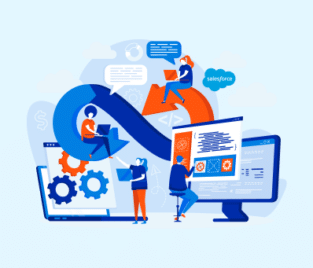Asset Management in Salesforce: Essential Topics You Need to Know
“Track all your Assets in Salesforce to get the most value from your Resources“
Do you know everything there is to know about your assets? Do you know when you have to replace, service, or dispose of them? These intricate details can assist your managers in making schedules to keep assets working at the most optimum level for your business while ensuring you don’t overspend on resources.
Join us in the article below as we learn about asset management in CRM and how Salesforce can be used to create the most effective workflows for your teams.

What is Asset Management?
It is a process to manage assets. The following items can fall within the assets category in a business:
- Products
- Equipment
- Software
- Other Valuable Items
Asset Management: Why is it Important?
Since asset management processes can be found in many industries, you know it’s a big deal. The following sectors use asset management daily:
- Financial Services
- Real Estate
- IT
- Manufacturing
One of the reasons why asset management is a main practice in these industries and more is because businesses need a way to improve the way they use their resources. When a business gets this right, it can use their assets to their full potential. This means businesses can minimize wastage and max out the value they receive from an asset.
Asset management can also empower executives to distribute assets to teams or departments that need the most help and, therefore, enhance the whole organization’s operations.
Many businesses take their asset management to Salesforce since the platform can enhance customer experiences as well. When asset details are uploaded to Salesforce they can be linked to customer data. Organizing data in this way on a single platform allows teams to respond faster and more accurately to customers.
As customers are a main priority for businesses, using Salesforce as an asset management CRM and source of truth for their customer data makes total sense.
The Benefits of Salesforce for Asset Managers
The best part about choosing Salesforce as your asset management CRM of choice is that you get tools and features to support your administration tasks and processes.
So, let’s dive deeper and look at some of the good stuff that makes Salesforce CRM one of the best options for asset management.
Track your Detailed and Well-Organized Assets
With asset management in Salesforce, companies can take their asset information game to the next level. A Salesforce integration gives executives features to upload complete information about assets. For example, Salesforce asset managers can add the following details to their org:
And that’s not where Salesforce asset management features stop working for companies. Managers can then organize all the uploaded asset information into hierarchies. Executives need this feature and capability, especially when they are tracking complex systems in their workplace. This feature is also essential for managing products that have many components.
This is an ideal feature from Salesforce CRM for asset managers!
Managing the Asset’s Entire Life Span
The next feature for asset management from Salesforce is a host of tools to monitor the lifecycle of assets. Managers can track every stage of an asset’s journey in the business, such as:
- The acquisition of an asset
- The launch of an asset
- The asset’s maintenance schedule
- Disposal of the asset from the company
By understanding the status of an asset or what condition it is in, managers can create plans to remind teams when assets need to be used, serviced, or retired. This feature form Salesforce CRM for asset managers is crucial for maintaining assets and using them in the most efficient manner.
Combining Client Relationship Management with Asset Management
The benefits we have already listed focused on internal practices. However, Salesforce is a customer relationship management platform first. So, don’t forget that you can use the platform to store all client information.
When you combine your CRM asset management information with customer details, you get to search and find more company data in a single location. This makes it easy to access vital information when you are searching for it.
Additionally, admins can organize more data on a single platform. This makes managing data and files easier as Salesforce becomes the source of truth for the company while reducing duplicated data in multiple locations that need to be constantly maintained.
Lead Generation with Asset Management
Salesforce also has robust tools and features to support lead generation. Once customer information is in Salesforce, asset managers can use tools to segment clients based on products they purchase and other criteria:
- Customer Profiles
- Customer Budgets
- Risks
With these detailed customer profiles created, asset managers can study their target groups and present them with tailored and preferred products or services.
Investor Onboarding and Account Management
If it’s time to start onboarding investors and managing accounts, Salesforce has got you covered. It has the capability to speed up the following tasks involved in processes that include:
- Workflows
- Client Experiences
- Compliance
For example, Salesforce has tools to automate the collection and distribution of documents from people who are involved in an onboarding process.
The Salesforce process is fairly straight-forward. Investors start by submitting forms online which are pushed to Salesforce, where submitted data can easily be tracked by asset managers online. This speedy data collection method can also be applied to customers who need to update their account details.
Overall, these features from Salesforce reduce administrative tasks for asset managers.
Workflow Automation
Although there are other benefits of using Salesforce for asset management, the last one we will discuss in our article pertains to automating workflows.
With Salesforce, we already discussed automating the collection of data through forms. What other workflows can it assist with?
For example, Salesforce can support your company with KYC (Know Your Customer) and AML (Anti-Money Laundering) regulations. The process involves Salesforce’s features that can be configured to collect and verify customer data. This is a common requirement for KYC and AML compliance. Once data has been confirmed to be accurate, Salesforce can activate the following tasks automatically:
- Activate Background Checks on Customers
- Validate Documents
- Point Out Any Discrepancies to be Checked
In this way, Salesforce’s workflow automation software does a great job in reducing errors for asset managers while ensuring compliance so that they can use their time more efficiently on higher-level tasks.
Frequently Asked Questions
What is an example of asset management?
It is the process of managing assets from end to end. Some common tasks in this process include creating, using, maintaining, servicing, and retiring assets. One of the main reasons for having these tasks in place is to manage budgets associated with looking after assets.
There are many examples for asset management, a common one is when a company manages client investments. Sometimes clients are too busy to manage their wealth, and need an external company to invest it wisely so it remains stable and grows. As asset management company can be approached by these individuals to support their investment portfolios.
What are the three main asset management types?
-
- Financial Asset Management
- Physical Asset Management
- Intangible Asset Management
What are the 5 core components of asset management?
-
- Asset Inventory and Identification
- Lifecycle Management
- Performance and Risk Management
- Financial Management
- Data and Information Management
Does Salesforce do asset management?
Yes, it does. You could use Salesforce Service Cloud for CRM asset management.
In general, Salesforce has tools and features for asset management to support company workflows related to its resources. Some of the functionality that teams can enjoy when using Salesforce for asset management include, the tracking of resources, scheduling of assets for maintenance, and inventory management.
What is asset and order management in Salesforce?
It’s a process to manage Salesforce assets and orders on your CRM platform. Now, it is normal for companies to have separate processes and tasks for asset and order management, but with Salesforce, the workflows can be integrated. This cohesion allows more departments to work on Salesforce to streamline business operations as a whole.
Wrapping Up Asset Management in Salesforce!
Thanks for reading our article on managing assets in Salesforce. We covered the basics like what is asset management and the benefits asset managers receive for using a platform like Salesforce for this popular business process. We then ended the article with some frequently asked questions about asset management in Salesforce.
If we missed a topic you would like to know more about to speed up your asset management activities with Salesforce, please feel free to reach out to us.
Additionally, if you want to achieve bigger business goals and scale with Salesforce, check out our Titan platform. It has no-code solutions for Salesforce to accelerate your business processes.
We can help you build Salesforce solutions without writing a line of code. This means you get to build processes and projects fast!
For more information on our products and services, contact us through one of our social media links below.
We hope to see you soon!

Disclaimer: The comparisons listed in this article are based on information provided by the companies online and online reviews from users. If you found a mistake, please contact us.



